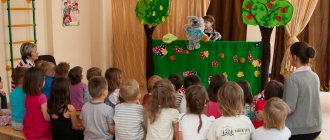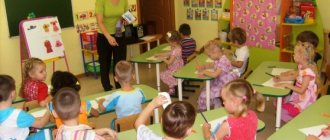Tasks.
Continue to introduce children to different types of folk arts and crafts. Learn to notice artistic elements that determine the specifics of “golden Khokhloma”: the purpose of objects, material, manufacturing technology (in the most general terms, accessible to children), color, pattern. Learn to draw patterns on paper from plant elements (grass, Kudrina, berries, flowers) based on Khokhloma painting, use decorative elements when designing homemade books. Develop technical skills - skillfully use a brush (paint with the tip of the brush, with the whole brush, move freely in different directions). To cultivate an aesthetic attitude towards everyday culture and objects of art.
Preliminary work.
Acquaintance with folk arts and crafts, conversation about traditional crafts. Excursion to a folk art museum or a local history museum (with a teacher, art historian or with parents on weekends.) Organization in kindergarten of a mini-museum or “museum in a suitcase” (“in a chest”), the exhibits of which can be antiques and folk decorative items -applied art brought by parents for temporary exhibition.
Preparation of “books” for illustration by children in three subsequent drawing classes. The teacher carries out this work himself or together with the children in independent artistic activities. The book is made as follows: two sheets of white paper are folded in half, one is inserted into the other and fastened with a stapler or sewn with a needle and thread.
Materials, tools, equipment.
Album for children's creativity "Golden Khokhloma", a guide to familiarize yourself with the characteristic elements and color combinations of different types of folk arts and crafts.
Contents of the lesson.
Before class, the teacher displays objects with Khokhloma painting on the table or on a large stand and invites the children to admire them.
An approximate story from a teacher “Golden Khokhloma”.
— The village of Khokhloma, Nizhny Novgorod region, where fairs selling wooden utensils and painted spoons have been held since ancient times, gave its name to a whole craft that is now widely known in our country and abroad. The village is called Khokhloma, and the dishes that are made here are also called “Khokhloma”. For many, many years, craftsmen here have been making wooden ladles, supplies (suppliers), bratins, spoons... Nowadays, craftsmen have learned to make modern sets of dishes - for juices, ice cream, jam, salads, etc., as well as decorative dishes, candlesticks, children's furniture.
All items made by folk craftsmen are very bright, elegant, festive, and colorful. For this, masters have to work hard. First, the dishes are cut out of wood or turned on a machine. Then they are covered with a layer of liquid clay, dried, soaked in linseed oil and slightly dried. After this, they are coated with a special metal powder and painted with beautiful patterns. Finally, they are coated with special oil (linseed oil) and dried in ovens. Metal powder and oil, after heating in an oven, give the products a unique golden shine, which is why the craft itself and all products are called “golden Khokhloma”. Gold - because all objects shine like gold.
Craftsmen choose paint colors for patterns that go well with the golden background. Which ones do you think? Yes! Red, black, green, brown and yellow. This is the peculiarity of this genre; it has its own strict rules.
Look at this dishes and tell me, what patterns do the craftsmen decorate their products with? Yes, the favorite patterns of the masters of Khokhloma painting are twigs, bushes, berries, and flowers. The twigs and bushes in these patterns are special. Masters love to paint them and affectionately call them “grass.” Sometimes artists paint grass as if all the leaves and blades of grass have turned into curls. Such branches and bushes are called “Kudrina” (from the words - curls, curly).
Consider these patterns (the teacher shows the children tables with options for elements and patterns). Now I will show you how to draw “grass” and “curls”. The teacher introduces the children to the options for floral patterns (see picture) and invites them to try to draw first the grass, and then berries and flowers. The teacher shows the children the basis of future baby books and explains that they themselves will draw pictures in these books to give them to the kids.
- Today we will draw a fabulous - golden - forest. Listen: golden forest - golden Khokhloma... Let's draw the forest like the Khokhloma masters. In this forest there will be bushes, twigs, trees with leaves - grass and Kudrina, with berries and flowers. Children draw a “golden forest” based on Khokhloma painting on the first spread of the book and at the end of the lesson they look at who got which forest and whether it looks like golden Khokhloma.
After class. Decorative drawing and appliqué based on Khokhloma painting - on a strip, circle, in the corners of the page of a future book (in the shape of a square or rectangle).
Progress of the lesson.
Khokhloma painting - a scattering of scarlet berries,
Echoes of summer in the green grass...
Guys, look at these products with Khokhloma painting . What is the name of the ornament depicted on them? (vegetable)
What is drawn here?
Look carefully - the strawberry can be large or small. What shape is the berry? (oblong)
We have observed that the color of the berries changes all the time while they are growing - from white, pink to bright red and deep crimson. So it turns out that on the same bush we see berries and leaves of different shapes, sizes and colors.
But even the same berry, the same plant changes, becoming a little different, from morning to evening, from one day to the next. The art of Khokhloma artists also reflected this variability.
Before we start drawing, let’s remember on which already familiar element we need to draw “ strawberry ”
?
(curl)
What already familiar elements can be used ? (grass, leaves, flowers)
How to draw the already known “curl” element
? (with the end of the brush, in a smooth movement, hold the brush with three fingers perpendicular to the sheet)
Children learn to draw strawberry , several people come out to demonstrate.
I clarify how the children will draw flowers (with a poke)
Ask 3-4 people to analyze your neighbor’s work.
Questions for analysis:
— “ strawberry ” element
?
— How is the pattern located?
elements carefully completed ?
Conversation “Acquaintance with the element of women's folk costume - kokoshnik” Goal: to introduce children to the element of women's folk costume - kokoshnik. Objectives: - tell children about the meaning of the kokoshnik as an element. Decorative painting based on Khokhloma painting Khokhloma painting is one of the oldest crafts in Russia, related to artistic applied art. Incredible. Consultation “History of Khokhloma painting” History of Khokhloma painting. Like beyond the Volga, hops curl above the bush. The wild hops have flown over to our side. How Life is on our side.
Abstract of GCD on Khokhloma painting “Chest-Ark” Summary of GCD on Artistic and Aesthetic Development. Topic: “Chest – Ark.” Khokhloma painting" Tasks: -continue to introduce children.
Summary of a lesson in the senior group on getting acquainted with the elements of Khokhloma painting “Rowanka” “Rowanka” Program content: 1. Continue teaching children to draw a wavy line with a smooth movement, simple leaves using a stroke.
Lesson on artistic and aesthetic development in the senior group “Decorative drawing based on Gzhel painting” Topic: “Decorative drawing based on Gzhel painting” Program objectives: continue to introduce children to Gzhel painting - its history.
Decorative drawing based on Khokhloma painting Abstract of an open lesson on visual arts in a preparatory group for school. Educator: Matryashina T. A. Date:.
Photo report from a class on decorative drawing of Khokhloma painting “Felt boots for Santa Claus” Felt boots for Santa Claus. Photo report of a class on decorative drawing (Khokhloma painting) Program content: Continue to introduce children. Lesson on plasticineography in the junior group “Strawberry Berry” CLASS ON PLASTILINEOGRAPHY IN THE YOUNGER GROUP “STRAWBERRY BERRY” Purpose: To teach children to draw a strawberry using the plasticineography technique. Tasks:. Introduction to Khokhloma painting. Photo report When getting acquainted with the folk applied arts of Russia, one cannot ignore Khokhloma painting. Born in a village with the name Khokhloma.
Source





